- News
- Reviews
- Bikes
- Components
- Bar tape & grips
- Bottom brackets
- Brake & gear cables
- Brake & STI levers
- Brake pads & spares
- Brakes
- Cassettes & freewheels
- Chains
- Chainsets & chainrings
- Derailleurs - front
- Derailleurs - rear
- Forks
- Gear levers & shifters
- Groupsets
- Handlebars & extensions
- Headsets
- Hubs
- Inner tubes
- Pedals
- Quick releases & skewers
- Saddles
- Seatposts
- Stems
- Wheels
- Tyres
- Tubeless valves
- Accessories
- Accessories - misc
- Computer mounts
- Bags
- Bar ends
- Bike bags & cases
- Bottle cages
- Bottles
- Cameras
- Car racks
- Child seats
- Computers
- Glasses
- GPS units
- Helmets
- Lights - front
- Lights - rear
- Lights - sets
- Locks
- Mirrors
- Mudguards
- Racks
- Pumps & CO2 inflators
- Puncture kits
- Reflectives
- Smart watches
- Stands and racks
- Trailers
- Clothing
- Health, fitness and nutrition
- Tools and workshop
- Miscellaneous
- Buyers Guides
- Features
- Forum
- Recommends
- Podcast
review
£900.00
VERDICT:
Comfortable and entertaining entry-to-mid-level bike, with excellent scope to upgrade in the future; change the tyres though
Weight:
9,540g
Contact:
www.trekbikes.com
At road.cc every product is thoroughly tested for as long as it takes to get a proper insight into how well it works. Our reviewers are experienced cyclists that we trust to be objective. While we strive to ensure that opinions expressed are backed up by facts, reviews are by their nature an informed opinion, not a definitive verdict. We don't intentionally try to break anything (except locks) but we do try to look for weak points in any design. The overall score is not just an average of the other scores: it reflects both a product's function and value – with value determined by how a product compares with items of similar spec, quality, and price.
What the road.cc scores meanGood scores are more common than bad, because fortunately good products are more common than bad.
- Exceptional
- Excellent
- Very Good
- Good
- Quite good
- Average
- Not so good
- Poor
- Bad
- Appalling
Over the past few years, Fabian Cancellara has romped to a podium in every cycling monument he has finished. Many of these performances have been on Trek's Domane endurance frames. Through the magic of trickle-down technology, the same platform that is available to Spartacus is available to you, in aluminium form, for a fraction of the cost which is what we have here in the Trek Domane 2.0.
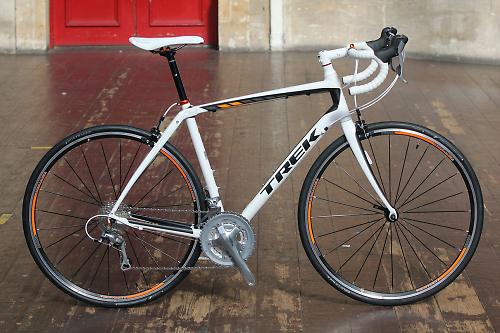
Frame/Fork: Quality products for the low price
The big talking point here for Trek is the ISOspeed decoupler. Essentially the seat tube isn't welded to the top tube/seat stay junction. The IsoSpeed itself consists of a bearing on either side, with a bushing forming the mechanical attachment between the top and seat tubes; this allows the whole length of the seat tube to flex under load. The initial, industry-standard 'lean on it to see what happens' test revealed a fair amount of flex in the frame - even in aluminium form, a material often known for building into frames that are a bit stiffer than carbon fibre equivalents.
On the road the compliance arising from that flex was noticeable - sometimes. I found that the frame's small bump sensitivity was not much different from other sportive or comfort bikes. However, when the going got even rougher - like on big potholes or really rough unpaved tracks akin to the cobbles of Flanders and Roubaix - the frame came into its own a bit more, softening the big hits.

The head tube is long at 17.5cm (I measured 17.3), and as such I found myself slamming the stem right down to the (quite tall) headset cap get my usual position (admittedly I run quite a racy position normally). Having said that, I have seen much longer head tubes on other endurance bikes too - Cervelo bikes spring to mind.
Build quality on this frame is excellent. The welds are all reasonably subtle, and there are both mudguard and rack mounts - a big plus for me, as I don't do riding on turbos throughout the rainy months, opting for the great outdoors instead. Similarly I was happy to find that the frame took 28mm tyres with a good few mm of room to spare. More on tyres in a minute.
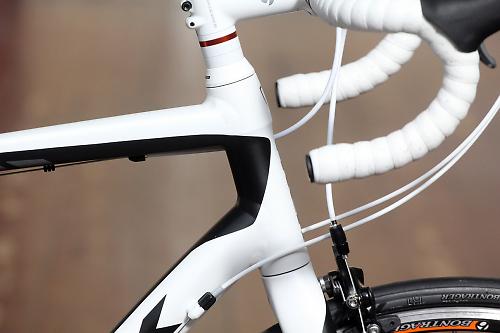
Press fit bottom brackets are becoming more and more prevalent on lower end bikes. You can make arguments for and against them. I tend to fall on the side of preferring threaded bottom brackets for ease of removal and maintenance, especially as the stiffness benefits of a press fit bottom bracket were not really all that tangible to me on a bike like this. However the cranks span flawlessly and there was no dreaded press fit creak to be heard.
Other than that I found the frame to be more than adequate. I can't say I stripped the bike down to get an actual weight of the bare frame, but it seemed pretty reasonable while out on the road. The paint finish was top notch - it ooked like I was riding a more expensive bike than I actually was.
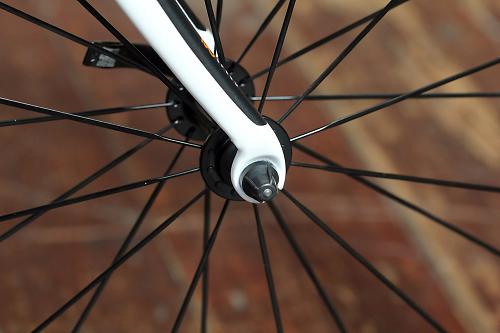
The Domane 2.0 fork is carbon, with an aluminium steerer. The fork is also an IsoSpeed product aiming to isolate road vibration, which manifests in the fork legs curving rather gracefully over the dropouts. The fork design works, but doesn't provide the same level of compliance as the rear end because the decoupler is a much more effective engineering solution. That led to a rather odd ride over certain road surfaces: there would be a lot of buzz through my hands, and then much less through the saddle. This is a minor point though, and I all but stopped noticing the difference as I became more accustomed to the bike. A way to compensate for this would be to run slightly less pressure than normal in the front tyre than the rear, or just fit plusher bar tape.
Build: Good value but a couple of changes needed.
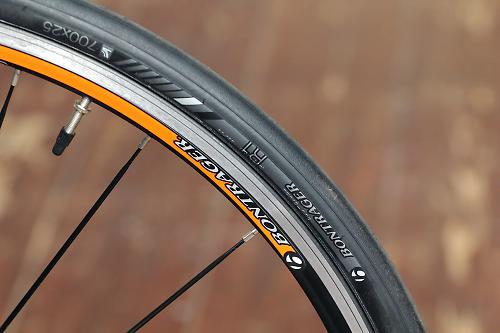
The Domane 2.0 is supplied with 25mm Bontrager R1 tyres. At first glance, on dry roads they seem like a decent idea. But at the first hint of rain or greasy roads, I didn't feel comfortable leaning the bike over in fast corners at all and found that the wheels would lock up rather too quickly for my liking. I did start to get used to them as I rode the bike more, but I was never fully at ease. Swtiching out to 28mm Continental Gatorskins - which aren't even the most supple of tyres - I was immediately more confident to really attack the descents.
The wheels are unbranded hubs laced to 'Bontrager-approved' rims with 24 spokes both front and rear. Unsurprisingly these wheels were no featherweights, but they performed perfectly well and weren't horrendously draggy on the climbs. The wheels also stayed true throughout the test, despite my best pothole and bridleway clattering, which was a bonus.
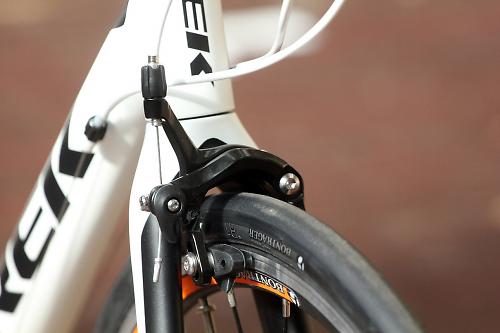
The unbranded alloy dual pivot brakes supplied were actually surprisingly powerful and had reasonable modulation. When combined with better tyres than those supplied, braking power was really excellent for the bike.
Trek supply the Domane 2.0 with a Shimano Tiagra group set. The group comes with a 50/39/30 triple up front and 12-30 10 speed cassette out back. Personally I'm not a fan of a triple - I've never run out of gears on a compact/28 cassette combo before - but with this combination I'd back myself to ride up a brick wall (provided enough science was ignored) and it complemented the considerable weight of the bike well. The cadence I could produce was epic, even on gradients of 20% or more. This is a big plus for those who might be just starting out in the world of cycling, or are looking to do some seriously tough and hilly days. It also meant I could do some sweet sweet wheelies up my local commute climb.
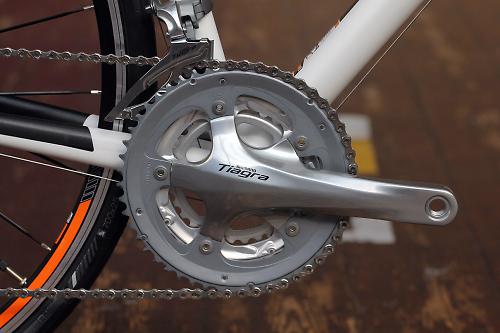
Out of the box I found that both derailleurs required a couple of barrel adjuster twiddles to really be sharp, but other than that the Tiagra performed excellently. I have a gripe with the Tiagra shifter hoods though. They are very big and even my average to large sized hands struggled when braking from the hoods. Shimanos 105 hoods are considerably more ergonomic in my eyes, and also do away with the 'washing line' gear cables coming out of the sides. That's purely an aesthetic factor though: my main problem is the ergonomics, or lack thereof.
The supplied bars - again 'Bontrager approved' - are 42cm wide. I ride 40cm bars on all my other bikes (that are 56cm, as with the bike on test) and the 2cm difference was noticeable. In my opinion the bike would have suited 40cm bars far better.
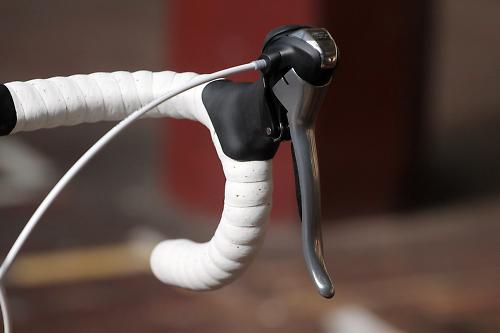
The Bontrager Affinity 1 saddle was rather good, sat atop the seat post that was another heavy but solid 'Bontrager approved' product. For longer rides I would personally have switched the saddle out for something that suits me better, but that sort of decision is always a very personal thing.
Ride: Comfy yet still responsive.
On the flat I found the Domane's weight to be unsurprisingly tough to accelerate up to speed, but the bike cruised well once you got it there. While climbing, again the hefty wheels held the bike back a bit, but it was comfortable both in and out of the saddle, and the triple chainset meant that I could scale any and all Tarmac grades I could find.
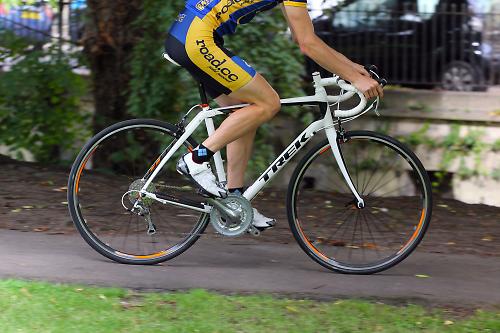
When pointed down the hill and getting into the drops (and with different tyres) the Trek was stable and surefooted. I had the bike up to almost 90kph down some of Bath's steeper declines and found I could bank the bike over in hard and fast corners with no hair-raising moments. The steering was reasonably responsive, potentially siding on the slow, rather than the twitchy side. But this was no problem for me and I really enjoyed hammering descents on it by the end of the test. This bike was never aimed to be a racer, but thankfully Trek have managed to marry the expected comfortable 'endurance' position for this bike with a lively steering response.
As pointed out before, at first the ride was slightly odd between front and rear wheel in terms of differing levels of road buzz, but overall I found it to be comfortable and never overly flexy. That's as close as I dare get to the dreaded 'compliance/stiffness' cliche.
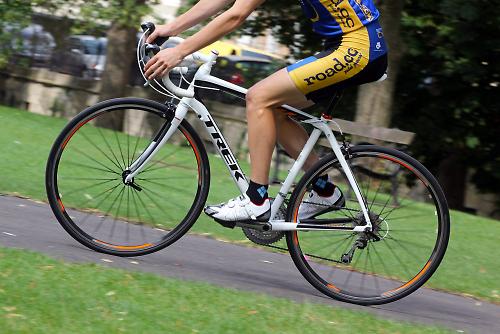
At the £900 mark, Trek have provided a frame and fork that is fully primed for some long term upgrades. If the bike were my own, my first priority would be to change the shifters and swap out the triple for a compact crankset. Upgrading these parts would cost more than the 200 jump up to the next bike in the range (the 2.3) but at the same time you are now out of the magic £1000 cycle to work scheme price point. So it's sort of swings and roundabouts really. Either way you are getting a top frame and fork for 900 quid, with perfectly functioning gears and excellent scope to upgrade in the future.
Verdict
Comfortable and entertaining entry-to-mid-level bike, with excellent scope to upgrade in the future; change the tyres though
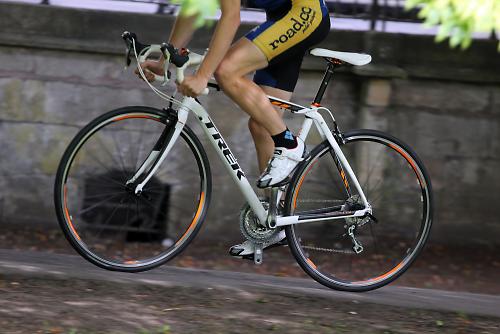
road.cc test report
Make and model: Trek Domane Two Series
Size tested: 56, White
About the bike
State the frame and fork material and method of construction. List the components used to build up the bike.
Frame
200 Series Alpha Aluminium, IsoSpeed
Fork
Trek IsoSpeed carbon, SpeedTrap compatible
Sizes
50, 52, 54, 56, 58, 60, 62cm
Frame fit
Endurance
Tell us what the bike is for, and who it's aimed at. What do the manufacturers say about it? How does that compare to your own feelings about the bike?
Wheels
Alloy hubs w/Bontrager Approved alloy rims
Tyres
Bontrager R1 Hard-Case Lite, 700x25c
Shifters
Shimano Tiagra STI, 10 speed
Front derailleur
Shimano Tiagra
Rear derailleur
Shimano Tiagra
Crank
Shimano Tiagra, 50/39/30 (triple)
Cassette
Shimano Tiagra 12-30, 10 speed
Saddle
Bontrager Affinity 1
Seatpost
Bontrager Approved, 27.2mm, 8mm offset
Handlebar
Bontrager Race VR-C, 31.8mm
Stem
Bontrager Race Lite, 31.8mm, 7 degree
Headset
1-1/8" integrated, semi-cartridge bearings
Brakeset
Alloy dual-pivot
Grips
Bontrager Gel Cork tape
Extras
Mudguard & rack mounts
Frame and fork
Overall rating for frame and fork
9/10
Tell us about the build quality and finish of the frame and fork?
Excellent build quality and finish here. In my opinion, with different parts hung off it, the bike could easily be passed off as a seriously expensive machine.
Tell us about the materials used in the frame and fork?
Aluminium Frame, with ISOspeed decoupler.
Carbon Fork (Aluminium Steerer)
Tell us about the geometry of the frame and fork?
The 56cm frame provided for test has:
71.9 ° Head angle
17.5cm Head tube length
73.3 ° Seat tube angle
55.4cm Effective top tube length
52.5cm Actual Seat tube length
100.8cm Wheelbase
These numbers all added up to a bike that I was at ease on very quickly.
How was the bike in terms of height and reach? How did it compare to other bikes of the same stated size?
Height and reach were both more "conservative" as you would expect from a bike aimed at endurance riding/racing. It was similar to most other bikes I've ridden in this category.
Riding the bike
Was the bike comfortable to ride? Tell us how you felt about the ride quality.
Yes, mostly comfortable. The decoupler isn't a complete game changer but it does cushion the big hits through the back wheel well.
The fork provides some compliance but it's not quite in the same league as the rear, leading to a bit of a difference between front and rear buzz over certain road surfaces.
Did the bike feel stiff in the right places? Did any part of the bike feel too stiff or too flexible?
No problems with stiffness, or lack thereof. I didn't have my marginal gains hat on for a bike like this but nonetheless it performed well.
How did the bike transfer power? Did it feel efficient?
It felt good - a bit sluggish compared to more expensive bikes but that's to be expected. For the price point it was great.
How would you describe the steering? Was it lively, neutral or unresponsive? Neutral - a smidge on the slow side. Not an issue at all though!
Which components had the most effect (good or bad) on the bike's comfort? would you recommend any changes?
Narrower 40cm bars would have suited the 56cm frame much better - or at least my taste and fit preference.
The Tiagra shifters - while excellent at changing gear - were massive and actually hindered me when attempting to brake from the hoods.
Which components had the most effect (good or bad) on the bike's efficiency? would you recommend any changes?
I don't know if it really falls under efficiency - but the tyres had to go. They were woeful in the wet and made the bike feel more than a bit sketchy.
Rate the bike for efficiency of power transfer:
8/10
Rate the bike for acceleration:
6/10
Rate the bike for sprinting:
6/10
Rate the bike for high speed stability:
9/10
Hit some of my fastest ever speeds on this bike (89kph to be exact!) and the bike felt great.
Rate the bike for cruising speed stability:
8/10
Rate the bike for low speed stability:
7/10
Rate the bike for flat cornering:
7/10
Rate the bike for cornering on descents:
9/10
With better tyres on it was really very surefooted.
Rate the bike for climbing:
6/10
The weight was always going to be a bit of a drag, but the triple helped out and it was comfortable to winch up a hill.
The drivetrain
Rate the drivetrain for performance:
8/10
The barrel adjusters needed a quick tune, and from then on the gears were excellent.
Rate the drivetrain for durability:
8/10
No issues.
Rate the drivetrain for weight:
6/10
A triple and a 12-30 cassette, Tiagra throughout. No surprises here that it was hefty.
Rate the drivetrain for value:
8/10
Bottom level drivetrain, works almost as well as any top end group. I love trickle-down tech.
Tell us some more about the drivetrain. Anything you particularly did or didn't like? Any components which didn't work well together?
I was not a fan of the shifters at all as they didn't feel good in my hands at all.
I'm not a triple man generally, but in this case it did help offset the weight of the bike a bit. Plus I think it suits the target market well.
Wheels and tyres
Rate the wheels and tyres for performance:
5/10
Wheels - OK. Tyres - dire
Rate the wheels and tyres for durability:
7/10
No worries here.
Rate the wheels and tyres for weight:
5/10
Heavy. Unsurprisingly.
Rate the wheels and tyres for comfort:
8/10
Wheels were fine.
Rate the wheels and tyres for value:
7/10
Cheap, but they worked well for what they were. And were expected for a bike of this price.
Tell us some more about the wheels and tyres.Did they work well in the conditions you encountered? Would you change the wheels or tyres? If so, what for?
I would (and did) change the tyres instantly. I went for 28mm Continental Gatorskins as that is what I had to hand, but any 28s would do to increase comfort and cornering grip.
Controls
Rate the controls for performance:
6/10
Rate the controls for durability:
8/10
Rate the controls for weight:
5/10
Unbranded - Heavy.
Rate the controls for comfort:
6/10
The bars annoyed me and the saddle wasnt great for long (100km plus) rides.
Rate the controls for value:
8/10
Tell us some more about the controls. Any particularly good or bad components? How would the controls work for larger or smaller riders?
I would swap out the bars for 40cm ones as it felt a bit wrong. I'd hope the next size down has 40cm bars or it would feel very odd indeed. In time I would personally change the saddle too.
Your summary
Did you enjoy riding the bike? With different tyres, yes
Would you consider buying the bike? If I were in the market for this kind of bike I would.
Would you recommend the bike to a friend? Yes.
Rate the bike overall for performance:
7/10
Rate the bike overall for value:
8/10
About the tester
Age: 21 Height: 182cm Weight: 73kg
I usually ride: On-One Carbon Whippet Single Speed MTB/Kinesis Pro6 My best bike is: Scott CR1 Pro
I've been riding for: 10-20 years I ride: Every day I would class myself as: Experienced
I regularly do the following types of riding: cyclo cross, commuting, club rides, sportives, general fitness riding, fixed/singlespeed, mtb,
Latest Comments
- CmdrBiggles 2 sec ago
Nice they are out of the box (28-622) and easy to fit, but my first puncture, in the centreline of the tread, occurred at 133km, and it was none of...
- Steve K 31 min 43 sec ago
There is still an advert free version on the app - you just need to make sure you click on the right feed (which will be the one with out a channel...
- kcr 4 hours 42 min ago
I think Livingston (no "e") has the best cycling infrastructure I have seen in Scotland. It has an extensive network of paths that are actually...
- kcr 5 hours 22 min ago
I'd say it is an extremely rare condition for most cyclists or runners.
- ErnieC 8 hours 7 min ago
or Team Bahrain ... selective outrage.
- newbankgyratory 9 hours 10 min ago
This website offers suitable data: https://www.automobiledimension.com/large-suv-4x4-cars.php
- newbankgyratory 9 hours 43 min ago
Perhaps park the goods in a US Customs Bonded warehouse and then import them out of there when the tariff nonsense settles down?...
- Dnnnnnn 7 hours 38 min ago
Good to see a road.cc review of what must be one of the UK's best-selling 'proper' road bikes....
- Miller 11 hours 56 min ago
Nice to see WvA featuring in the finale.
- Miller 11 hours 59 min ago
I have known more than one elder statesman of the club die of a heart failure while out on a ride. Sometimes I feel that's about to happen to me,...



































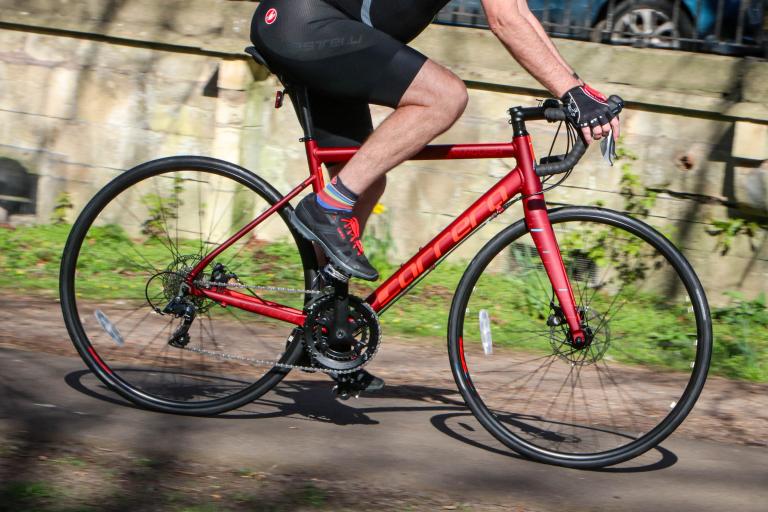



Add new comment
5 comments
How might this compare - for comfort - to a vintage steel racer?
Hi there, Markus. While steel is real, and still the stuff of legend, it's not going to be as compliant simply by nature of the fact that it doesn't have a decoupler. It's that particular piece of tech that separates the Domane from pretty much anything else out there.
The proof is in the pudding though, and anything else I might say will make me sound like a typical marketing shill. A test ride on one, ideally immediately after riding a different bike on the same stretch, will really be all you need to understand the effects of the decoupler.
Completely agree with you re those tyres.
Last year, I bought a Trek Madone 2.1 which had Bontrager R1s on (700 x 23c). A month into my proud new ownership, I'm riding downhill at approx 20mph in north Wales. The road was wet as I braked approaching a mini roundabout. The tyres did just what you described. I came off, blacked out, and ended up in an ambulance with road rash. Thankfully, the Trek got off with very minor damage. The tyres were binned as soon as I got home though.
Trek dealers should be made to pull them straight away.
Good to know about the R1 tyres. I'm picking up a new Madone 2.1 in a couple of weeks - I will be sure to change them out and sell the tyres on as quickly as I can!
Agree they are fairly horrific and shouldn't appear on the bikes in future. They were the only thing I felt I absolutely had to change on my 2013 Domane 2.0, other than that it is/was a cracking ride.